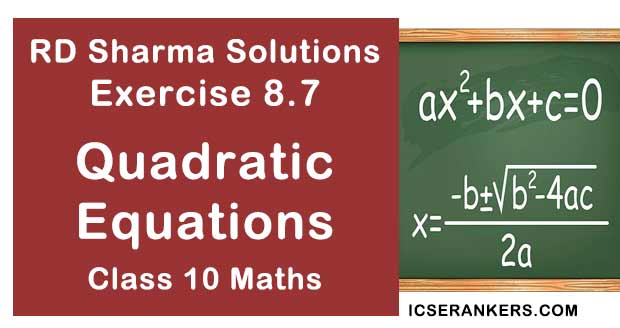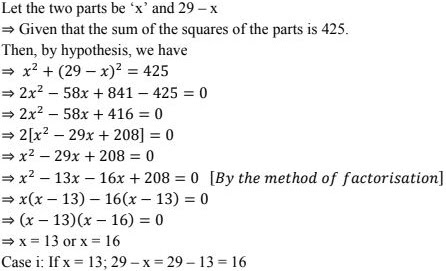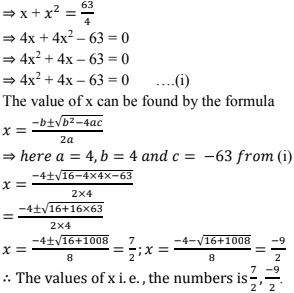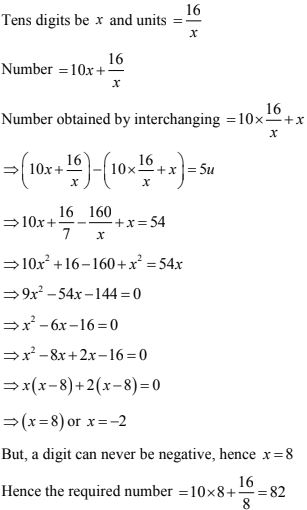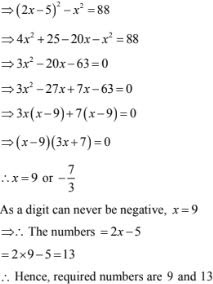RD Sharma Solutions Chapter 8 Quadratic Equations Exercise 8.7 Class 10 Maths
Chapter Name | RD Sharma Chapter 8 Quadratic Equations |
Book Name | RD Sharma Mathematics for Class 10 |
Other Exercises | - Exercise 8.1
- Exercise 8.2
- Exercise 8.3
- Exercise 8.4
- Exercise 8.5
- Exercise 8.6
- Exercise 8.8
- Exercise 8.9
- Exercise 8.10
- Exercise 8.11
- Exercise 8.12
- Exercise 8.13
|
Related Study | NCERT Solutions for Class 10 Maths |
Exercise 8.7 Solutions
1. Find the consecutive numbers whose squares have the sum 85.
Solution
Let the two consecutive natural numbers be 'x' and 'x + 1'
Given that the sum of their squares is 85.
Then by hypothesis, we get
x2 + (x + 1)2 = 85
⇒ x2 + x2 + 2x + 1 = 85
⇒ 2x2 + 2x + 1 - 85 = 0
⇒ 2x2 + 2x + 84 = 0 ⇒ 2[x2 + x - 42] = 0
⇒ x2 + 7x - 6x - 42 = 0 [by the method of factorisation]
⇒ x(x + 7) - 6(x + 7) = 0
⇒ (x - 6)(x + 7) = 0
⇒ x = 6 or x = 7
case i : if x = 6x + 1 = 6 + 1 = 7
case ii: if x = 7x + 1 = - 7 + 1 = - 6
∴ The consecutive numbers that the sum of this squares be 85 are 6, 7 and -6, - 7.
2. Divide 29 into two parts so that the sum of the squares of the parts is 425.
Solution
Case ii: x = 16; 29 - x = 29 - 16 = 13
∴ The two parts that the sum of the squares of the parts is 425 are 13, 16.
3. Two squares have sides x cm and (x + 4)cm. The sum of this areas is 656 cm2 . Find the sides of the squares.
Solution
The given sides of two squares = x cm and (x + 4)cm
The sum of their areas = 656 cm2 .
The area of the square = side × side
∴ Area of the square = x(x + 4) cm2
⇒ Given that sum of the areas is 656 cm2 .
Hence by hypothesis, we have
⇒ x(x + 4) + x(x + 4) = 656
⇒2x(x + 4) = 656
⇒ x2 + 4x = 328 [dividing both sides by 2]
⇒ x2 + 4c - 328 = 0
⇒ x2 + 20x - 16x - 328 = 0 [∵ by the method of factorisation]
⇒ x(x + 20) - 16(x + 20) = 0
⇒ (x + 20)(x - 16) = 0 ⇒ x = -20 or x = 16
Case i: If x = 16; x + 4 = 20
∴ The sides of the squares are 16 cm and 20cm.
Note : No negative value is considered as the sides will never be measured negatively.
4. The sum of two numbers is 48 and their product is 432. Find the numbers
Solution
Given the sum of two numbers is 48
Let the two numbers be x and 48 - x also given their product is 432.
Hence x(48 - x) = 432
⇒ 48x - x2 = 432
⇒ 48x - x2 - 432 = 0
⇒ x2 - 48x + 432 = 0
⇒ x2 - 36x - 12x + 432 = 0 [By method of factorisation]
⇒ x(x - 36) - 12(x - 36) = 0
⇒ (x - 36)(x - 12) = 0
⇒ x = 36 or x = 12
∴ The two numbers are 12, 36.
5. If an integer is added to its square, the sum is 90. Find the integer with the help of quadratic equation.
Solution
Let the integer be 'x'
Given that if an integer is added to its square, the sum is 90.
⇒ x + x2 = 90
⇒ x + x2 - 90 = 0
⇒ x2 + 10x - 9x - 90 = 0
⇒ x(x + 10) - 9(x + 10) = 0
⇒ x = - 10 or x = 9
∴ The value of an integer are -10 or 9.
6. Find the whole numbers which when decrease by 20 is equal to 69 times the reciprocal of the members.
Solution
Let the whole number be x as it is decreased by 20 ⇒ (x - 20) = 69.(1/2)
As the whole numbers are always positive, x = - 3 is not considered.
∴ The whole number x = 23.
7. Find the two consecutive natural numbers whose product is 20.
Solution
Let the two consecutive natural numbers be 'x' and 'x + 2'
⇒ Given that the product of the natural numbers is 20
Hence ⇒ x(x + 1) = 20
⇒ x2 + x = 20
⇒ x2 + x - 20 = 0
⇒ x2 + 5x - 4x - 20 = 0
⇒ x(x + 5) - 4(x + 5) = 0
⇒ x = - 5 or x = 4
Considering positive value of x as x ∈ N
For r = 4, x + 1 = 4 + 1 = 5
∴ The two consecutive natural numbers are 4 as 5.
8. The sum of the squares of the two consecutive odd positive integers as 394. Find them.
Solution
Let the consecutive odd positive integers are 2x - 1 and 2x + 1
Given that the sum of the squares is 394.
(2x - 1)2 + (2x + 1)2 = 394
4x2 + 1 - 4x + 4x2 + 1 + 4x = 394
8x2 + 2 = 394
4x2 = 392
x2 = 36
x = 6
As x = 6,
2x - 1 = 2×6 - 1 = 11
2x + 1 = 2×6 + 1 = 13
∴ The two consecutive odd positive numbers are 11 and 13.
9. The sum of two numbers is 8 and 15 times the sum of their reciprocals is also 8. Find the numbers.
Solution
Let the numbers be x and 8 -x
Given that the sum of these numbers is 8
And 15 times the sum of their reciprocals as 8

10. The sum of a numbers and its positive square root is 6/25. Find the numbers. Solution
Let the number be x
By the hypothesis we have
⇒ x + √x = 6/25

11. The sum of a number and its square is 63/4. Find the numbers.
Solution
Let the number be x.
Given that the sum of x and its square = 63/4
12. There are three consecutive integers such that the square of the first increased by the product of the first increased by the product of the others the two gives 154. What are the integers?
Solution
Let the three consecutive numbers x, x + 1 and x + 8.
According to the hypothesis given

Solution
Given that the product of two successive integral multiples of 5 is 300.
Let the integers be 5x, and 5(x + 1)
Then, by the integers be 5x and 5(x + 1)
Then, by the hypothesis, we have
5x . 5(x + 1) = 300

14. The sum of the squares of two numbers as 233 and one of the numbers as 3 less than twice the other number find the numbers.
Solution
Let the number be x
Then the other number = 2x - 3
According to the given hypothesis,

15. Find the consecutive even integers whose squares have the sum 340.
Solution
Let the consecutive even integers be 2x and 2x + 2.
Then according to the given hypothesis,

16. The difference of two numbers is 4. If the difference of their reciprocals is 4/21. Find the numbers .
Solution
Let the two numbers be x and x - 4
Given that the difference of two numbers is 4.
By the given hypothesis, we have 1/(x - 4) - 1/x = 4/21
17. Let us find two natural numbers which differ by 3 and whose squares have the sum 117.
Solution
Let the numbers be x and x = 3
By the given hypothesis,

18. The sum of the squares of three consecutive natural numbers as 149. Find the numbers.
Solution
19. Sum of two numbers is 16. The sum of their reciprocals is 1/3. Find the numbers. Solution
Given that the sum of two number is 16.
Let the two numbers be x and 16 -x
By the given hypothesis, we have

20. Determine two consecutive multiples of 3, whose product is 270.
Solution
Let the two consecutive multiples of 3 are 3x and 3x + 3
Given that their product is 270

21. The sum of a number and its reciprocal is 17/4. Find the number.
Solution
Let the number be 'x'.
According to the given hypothesis

Solution
Let the two digits be x and x - 2
Given that the product of their digits is 8.

23. A two digits number is such that the product of the digits is 12. When 36 is added to the number, the digits inter change their places determine the number
Solution
Let the tens digit be x

Solution
Let the two digits be:
25. Two numbers differ by 3 and their product is 504. Find the number
Solution
Let the two numbers be x and x - 3 given that x(x - 3) = 504
26. Two number differ by 4 and their product is 192. Find the numbers ?
Solution
Let the two numbers be x and x - 4
Given that their product is 192

27. A two - digit number is 4 times the sum of its digits and twice the product of its digits. Find the numbers.
Solution
Let the digits at tens and units place of the number be x and y respectively then, it is
given that = 10x + y
⇒ 10x + y = 4 (sum of digits) and 2xy
⇒ 10x + y = 4(x + y) and 10x + y = 3xy
⇒ 10x + y = 4x + 4y and 10x + y = 3xy
⇒ 6x - 3y = 0 and 10x + y - 3xy = 0
⇒ y = 2x and 10x + 2x = 2xy(2x)
⇒ 12x = 4x2
⇒ 4x2 - 12x = 0
⇒ 4x(x - 3) = 0
⇒ 4x = 0 or x = 3
⇒ here we have y = 2x ⇒ 2×3 = 6
∴ x = 3 and y = 6
Hence 10x + y = 10×3+6 = 36
∴ The required two digit number is 36.
28. The sum of the squares of two positive integers is 208. If the square of the large number is 18 times the smaller. Find the numbers
Solution
Let the smaller number be x. Then square of a larger number = 18x
Also, square of the smaller number = x2
It is given that the sum of the square of the integers is 208.
But, the numbers are positive. Therefore x = 8
∴ square of the larger number = 18x = 18 × 8 = 144
⇒ larger number are 8 and 18.
29. The sum of two numbers is 18. The sum of their reciprocals is 1/4. Find the numbers
Solution
Let the number be x and 18 - x
⇒ according to the given hypothesis
30. The sum of two numbers a and b is 15. And the sum of their reciprocals 1/a and 1/b is 3/10Find the numbers a and b.
Solution
Let us assume a number 'x'
∴ a = 5, b = 10 or a = 10 and b = 5
31. The sum of two numbers is 9. The sum of their reciprocals is 1/2. Find the numbers.
Solution
Given that the sum of two numbers is 9. Let the two numbers be x and 9 - x
By the given hypothesis, we have
32. Three consecutive positive integers are such that the sum of the square of the first and the product of other two is 46. Find the integers.
Solution
Let the three consecutive positive integers be x, x + 1 and x + 2
According to the hypothesis, we have
33. The difference of squares of two numbers is 88. If the larger number is 5 less than twice the smaller number, then find the two numbers.
Solution
Let the smaller number be x. Then, larger number = 2x - 5
It is given that the difference of the square of the number is 88.
34. The difference of square of two numbers is 180, the square of the smaller number is 8 times the large numbers find two numbers. Solution
Let the number be x
By the given hypothesis, we have

Square of larger number 8x = - 80 here no perfect square exist, hence the numbers are 18, 12.
